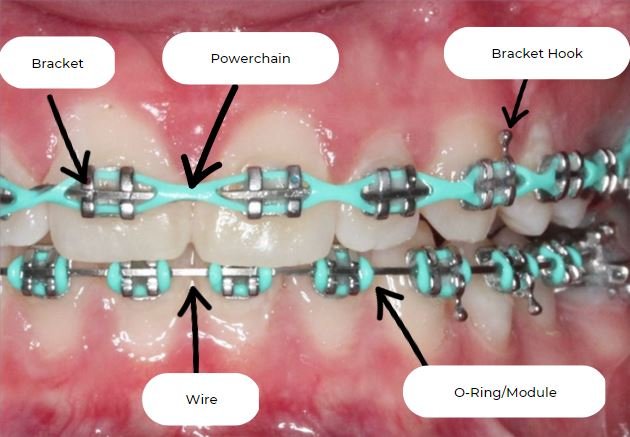
Essential Information for patients with:
Fixed Braces
If you are experiencing any issues regarding your retainers and are unable to visit us for an appointment, please use this helpful information guide.
For our patients with fixed braces, please follow the instructions below, and read on for handy tips on how to manage minor orthodontic breakages from home.
Excellent oral hygiene is essential.
Excellent hand hygiene is essential.
Avoid consuming sweetened beverages or foods.
Avoid all hard or crunchy foods.
Follow the instructions provided at your last visit, such as the wear of elastics or brushing your teeth, unless advised otherwise.
If you have any problem causing concern please take a photo and email it us. You are also welcome to call us with any additional questions you may have.
DIAGRAM
Please use the labelled diagrams of the different braces elements as reference when you are describing the issue.
Possible Scenarios
Loose or broken bracket?
A bracket refers to the individual braces glued onto each tooth.
To manage a broken or displaced bracket, the first tip is to avoid breakages in the first place. This is achieved by avoiding hard, sticky/chewy foods and any knocks or excessive pressure to the brackets (contact sports without a mouth guard, chewing on pens etc.). If you do break a bracket, follow these steps:
Take a picture of the broken bracket and email it to us at your earliest convenience.
Your specialist orthodontist will review the photographs and let you know how to proceed.
If the bracket is rotated and pushing into the gums, you can use tweezers to flip it back into position and minimise irritation.
Alternatively, you can use tweezers to remove the plastic o-ring that holds the bracket to the wire so that the bracket detaches completely.
Sore gums?
You may experience sore gums or ulcers from the brackets, wires, or molar bands rubbing against the inside of your mouth. Orthodontic wax can be used to sooth this and is provided to you at the start treatment and purchasable from the local chemist.
Take a small bit of wax and roll it into a ball around the size of the bracket.
Ensuring the section of the mouth and braces are completely dry, push the wax onto the bracket, which is causing the irritation, as above.
Use warm water salt rinses 3 times a day to sooth irritation and discomfort.
Long wire?
As your teeth move, the end of the wire may shift causing it to stick out at the back, poking you in the cheek or gum. You can attempt to slide the wire back, re-centring it. If this does not resolve the issue you can follow these steps:
1. Attempt to use nail clippers or nail scissor to clip the wire., or alternatively try to tuck the wire away from your cheeks using tweezers.
2. If you are uncomfortable cutting the wire yourself, please call the clinic to book an appointment with your doctor. In the meantime, use orthodontic wax at the end of the wire to prevent ulceration (make sure the area is dry before application).
Lost an o-ring?
O-rings or modules refer to the small rubber ring that circulates each bracket, holding the wire in place. If an O-ring becomes partially detached, you can attempt to use a pair of tweezers to pull the o-ring back over the four corners of the bracket.
If the o-ring falls off completely, please note that this is not urgent unless the tooth starts moving significantly out of alignment. In this case, please send a photo to info@edgeclifforthodontics.com.au and we will review this.
Broken powerchain?
Powerchain is made of an elastic material and consist of many connected rings. If your powerchain snaps or becomes detached, please understand that this is not urgent. You can take a photo and email it to the clinic so we can advise whether an extra visit is necessary.






